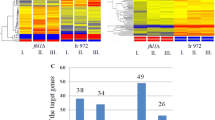Summary
SME1 was cloned due to its high copy number effect: it enabled MATα/MATα diploid cells to undergo meiosis and sporulation in a vegetative medium. Disruption of SME1 resulted in a recessive Spo− phenotype. These results suggest that SME1 is a positive regulator for meiosis. DNA sequencing analysis revealed an open reading frame of 645 amino acids. An amino terminal peptide of ca 400 amino acids in the deduced protein was similar to known protein kinases. Transcription of SME1 was regulated negatively by nitrogen and glucose and positively by MATα/MATα and IME1, another positive regulator gene of meiosis. By complementation analysis, SME1 was found to be identical to IME2, which had been shown to be important in meiosis. These results suggest that IME1 product stimulates meiosis by activating transcription of SME1 (IME2) and that protein phosphorylation is required for initiation of meiosis.
Similar content being viewed by others
References
Bennett MK, Kennedy MB (1987) Deduced primary structure of the beta subunit of brain type II Ca+/calmodulin-dependent protein kinase determined by molecular cloning. Proc Natl Acad Sci USA 84:1794–1798
Bolivar F, Rodriguez RL, Greene PJ, Betlach MC, Heyneker HL, Boyer HW, Crosa JH, Falkow S (1977) Construction and characterization of new cloning vehicles, II. A multipurpose cloning system. Gene 2:95–113
Broach JR, Strathern JN, Hicks JB (1979) Transformation in yeast: development of a hybrid cloning vector and isolation of the CAN1 gene. Gene 8:121–133
Casadaban MJ, Martinez-Arias A, Shapira SK, Chou J (1983) β-galactosidase gene fusions for analyzing gene expression in Escherichia coli and yeast. Methods Enzymol 100:293–308
Czernilofsky AP, Levinson AD, Varmus HE, Bishop JM, Tischer E, Goodman HM (1983) Corrections to the nucleotide sequence of the src gene of Rous sarcoma virus. Nature 301:736–738
Elion EA, Warner JR (1984) The major promoter element of rRNA transcription in yeast lies 2 kb upstream. Cell 39:663–673
Esposito RE, Klapholz S (1981) Meiosis and ascospore development. In: Strathern JN, Jones EW, Broach JR (eds) The molecular biology of the yeast Saccharomyces: life cycle and inheritance. Cold Spring Harbor Laboratory Press, Cold Spring Harbor, New York, pp 211–287
Goddard JM, Weiland JJ, Capecchi MR (1986) Isolation and characterization of Caenorhabditis elegans DNA sequences homologous to the v-abl oncogene. Proc Natl Acad Sci USA 83:2172–2176
Kassir Y, Simchen G (1976) Regulation of mating and meiosis in yeast by the mating type locus. Genetics 82:187–206
Kassir Y, Granot D, Simchen G (1988) IME1, a positive regulator gene of meiosis in S. cerevisiae. Cell 52:853–862
Leader DP (1988) Identification of protein kinases by computer. Nature 333:308
Lee MG, Nurse P (1987) Complementation used to clone a human homologue of the fission yeast cell cycle control gene cdc2. Nature 327:31–35
Lorincz AT, Reed SI (1984) Primary structure homology between the product of yeast cell division control gene CDC28 and vertebrate oncogenes. Nature 307:183–185
Maller JL, Krebs EG (1977) Progesterone-stimulated meiotic cell division in Xenopus oocytes. Induction by regulatory subunit and inhibition by catalytic subunit of adenosine 3′:5′-monophosphatek-dependent protein kinase. J Biol Chem 252:1712–1718
Mann C, Davis RW (1986) Structure and sequence of the centromeric DNA of chromosome 4 in Saccharomyces cerevisiae. Mol Cell Biol 6:241–245
Matsumoto K, Uno I, Ishikawa T (1983) Initiation of meiosis in yeast mutants defective in adenylate cyclase and cyclic AMPdependent protein kinase. Cell 32:417–423
McLeod M, Beach D (1988) A specific inhibitor of the ran1 + protein kinase regulates entry into meiosis in Schizosaccharomyces pombe. Nature 332:509–514
McMaster GK, Carmichael GG (1977) Analysis of single- and double-stranded nucleic acids on polyacrylamide and agarose gels by using glyoxal and acridine orange. Proc Natl Acad Sci USA 74:4835–4838
Miller J (1972) Experiments in molecular genetics. Cold Spring Harbor Laboratory Press, Cold Spring, New York
Mitchell AP, Herskowitz I (1986) Activation of meiosis and sporulation by repression of the RME1 product in yeast. Nature 319:738–742
Nadin-Davis SA, Nasim A (1988) A gene which encodes a predicted protein kinase can restore some functions of the ras gene in fission yeast. EMBO J 7:985–993
Sanger F, Nicklen S, Coulson AR (1977) DNA sequencing with chain-terminating inhibitors. Proc Natl Acad Sci USA 74:5463–5467
Saxena A, Padmanabhan RV, Glover CVC (1987) Isolation and sequencing of cDNA clones encoding the alpha and beta subunits of Drosophila casein kinase II. Mol Cell Biol 7:3409–3417
Smith HE, Mitchell AP (1989) A transcriptional cascade governs entry into meiosis in Saccharomyces cerevisiae. Mol Cell Biol 9:2142–2152
Southern EM (1975) Detection of specific sequences among DNA fragments separated by gel electrophoresis. J Mol Biol 98:503–517
Struhl K, Stinchcomb DT, Scherer S, Davis RW (1979) Highfrequency transformation of yeast: autonomous replication of hybrid DNA molecules. Proc Natl Acad Sci USA 76:1035–1039
Suzuku K, Imai Y, Yamashita I, Fukui S (1983) In vivo ligation of linear DNA molecules to circular forms in the yeast Saccharomyces cerevisiae. J Bacteriol 155:747–754
Thomas PS (1980) Hybridization of denatured RNA and small DNA fragments transferred to nitrocellulose. Proc Natl Acad Sci USA 77:5201–5205
Toda T, Uno I, Ishikawa T, Powers S, Kataoka T, Broek D, Cameron S, Broach J, Matsumoto K, Wigler M (1985) In yeast, RAS proteins are controlling elements of adenylate cyclase. Cell 40:27–36
Toda T, Cameron S, Sass P, Zoller M, Wigler M (1987) Three different genes in S. cerevisiae encode the catalytic subunits of the CAMP-dependent protein kinase. Cell 50:277–287
Yamashita I, Maemura T, Hutano T, Fukui S (1985) Polymorphic extracellular glucoamylase genes and their evolutionary origin in the yeast Saccharomyces diastaticus. J Bacteriol 161:574–582
Yamashita I, Nakamura M, Fukui S (1987) Gene fusion is a possible mechanism underlying the evolution of STA1. J Bacteriol 169:2142–2149
Author information
Authors and Affiliations
Additional information
Communicated by C.P. Hollenberg
Rights and permissions
About this article
Cite this article
Yoshida, M., Kawaguchi, H., Sakata, Y. et al. Initiation of meiosis and sporulation in Saccharomyces cerevisiae requires a novel protein kinase homologue. Molec. Gen. Genet. 221, 176–186 (1990). https://doi.org/10.1007/BF00261718
Received:
Issue Date:
DOI: https://doi.org/10.1007/BF00261718




